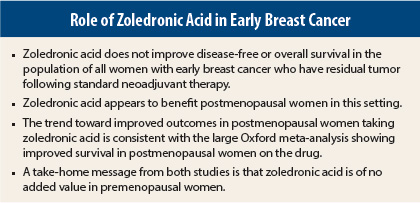Zoledronic acid does not improve outcomes in patients with early breast cancer who do not have a full response to neoadjuvant anthracycline/taxane–based chemotherapy, according to results of the Neo-Adjuvant Trial Add-On (NATAN) study presented at the 2013 San Antonio Breast Cancer Symposium.1 A trend was observed for some benefit of zoledronic acid in women over 55 years old, consistent with the Early Breast Cancer Trialists’ Collaborative Group (EBCTCG) meta-analysis (aka “Oxford Overview”) on the effects of bisphosphonates, reported at the same meeting.2
“There are not a lot of postsurgery options for patients with residual disease after neoadjuvant chemotherapy who we consider chemoresistant. In this first randomized postneoadjuvant study investigating zoledronic acid in patients without a pathologic complete response after neoadjuvant chemotherapy, no benefit was observed,” stated lead author Gunter von Minckwitz, MD, PhD, Chairman of the German Breast Group and Professor of Gynecology at the University of Frankfurt, Germany.
NATAN Trial Details
The phase III NATAN trial enrolled 693 women with early breast cancer and residual tumor after two cycles of neoadjuvant chemotherapy with anthracycline and taxane between 2005 and 2009. After surgery, the women were randomly assigned to receive or not receive treatment with intravenous zoledronic acid every 4 weeks for 6 months, then every 3 months for 2 years, then every 6 months for 2.5 years, for a total of 5 years.
Treatment arms were well balanced for demographic and disease characteristics. Mean age was about 50; about one-third were over age 55 years; about 72% had ductal invasive carcinoma; 31% had grade 3 disease; about 79% were hormone receptor–positive, and 17% were HER2-positive; 15% had stable disease or progressive disease following neoadjuvant chemotherapy. Prior and/or simultaneous trastuzumab (Herceptin), endocrine therapy, and radiotherapy were allowed.
A preplanned interim analysis was undertaken because the observed event rate at 48 months was 148, which was only 50% of the required rate. It would have taken another 6 to 8 years to reach the required 316 events for a final analysis, Dr. von Minckwitz explained.
Key Outcomes
No significant difference in disease-free survival (P = .7885) or overall survival (P = .4082) was observed between the two treatment arms. Furthermore, no subgroup had a significant advantage with zoledronic acid. However, a nonsignificant trend favored zoledronic acid in women over age 55, showing a 17% reduction in risk of progression.
“This is consistent with the risk reduction in postmenopausal women shown in the Oxford meta-analysis presented at this meeting. It is the older women who benefit from zoledronic acid,” Dr. von Minckwitz said. “Better patient selection is needed to study future compounds in this setting,” he added.
“We would need a very large trial to show the benefit of zoledronic acid. The Oxford meta-analysis included 7,000 patients and 36 randomized controlled trials,” Dr. von Minckwitz noted.
Complicated Trials
Other postneoadjuvant treatment options under study in chemoresistant breast cancer patients include rucaparib (an oral PARP inhibitor) for triple-negative breast cancer, palbociclib in women with hormone receptor–positive/HER2-negative disease, and ado-trastuzumab emtansine (Kadcyla) in patients with chemoresistant HER2-positive disease.
“We experienced a number of challenges while conducting this study and are sharing what we have learned with other researchers considering running these extremely complicated trials,” he noted. ■
Disclosure: Dr. von Minckwitz has received research grants from Novartis and Roche and consultancy honoraria from Roche.
References
1. von Minckwitz G, Rezai M, Eidtmann H, et al: Postneoadjuvant treatment with zoledronate in patients with tumor residuals after anthracyclines-taxane-based chemotherapy for primary breast cancer: The phase III NATAN study (GBG 36/ABCSG XX). 2013 San Antonio Breast Cancer Symposium. Abstract S5-05. Presented December 13, 2013.
2. Coleman R, Gnant M, Paterson A, et al: Effects of bisphosphonate treatment on recurrence and cause-specific mortality in women with early breast cancer: A meta-analysis of individual patient data from randomised trials. 2013 San Antonio Breast Cancer Symposium. Abstract S4-07. Presented December 12, 2013.



